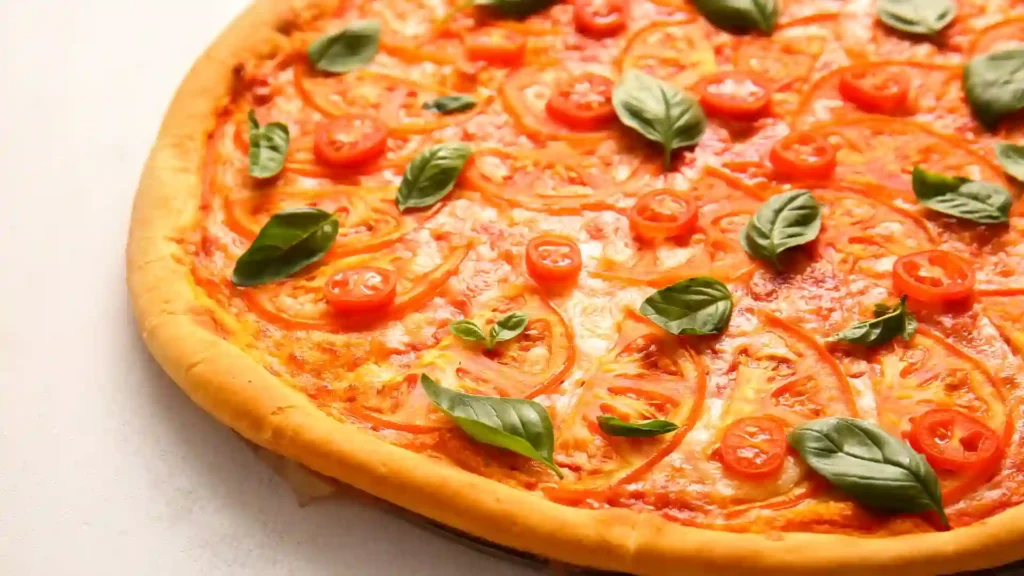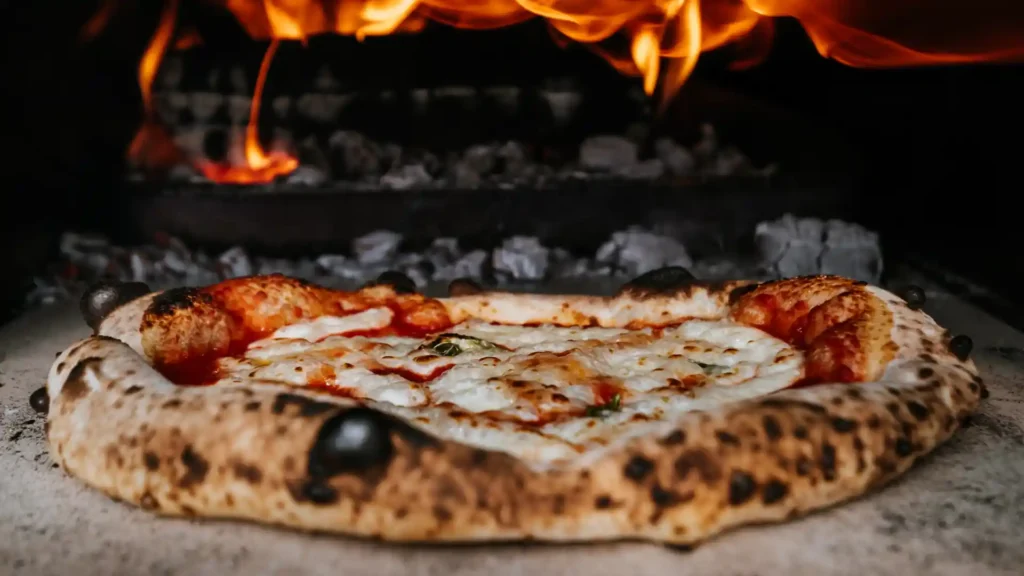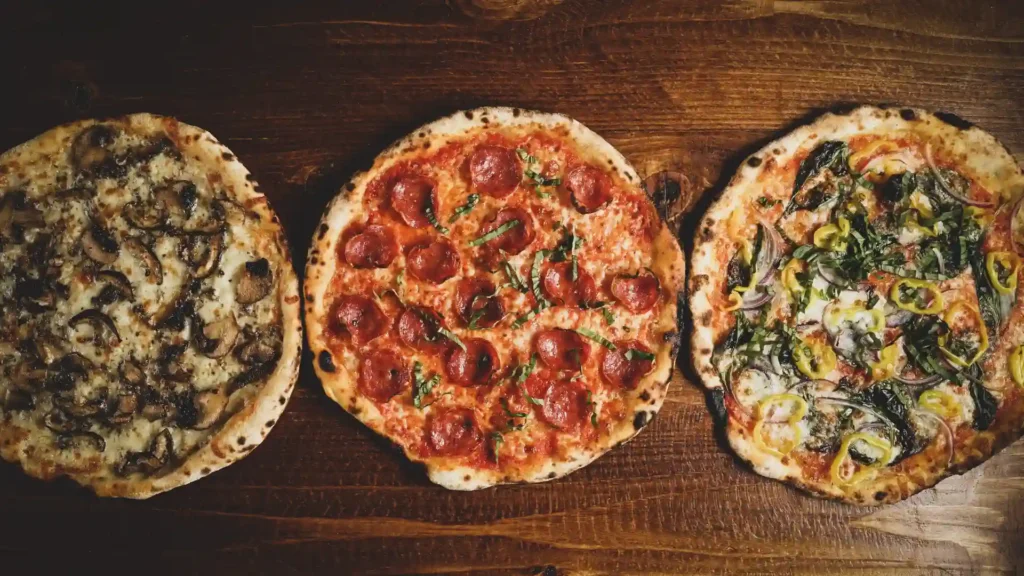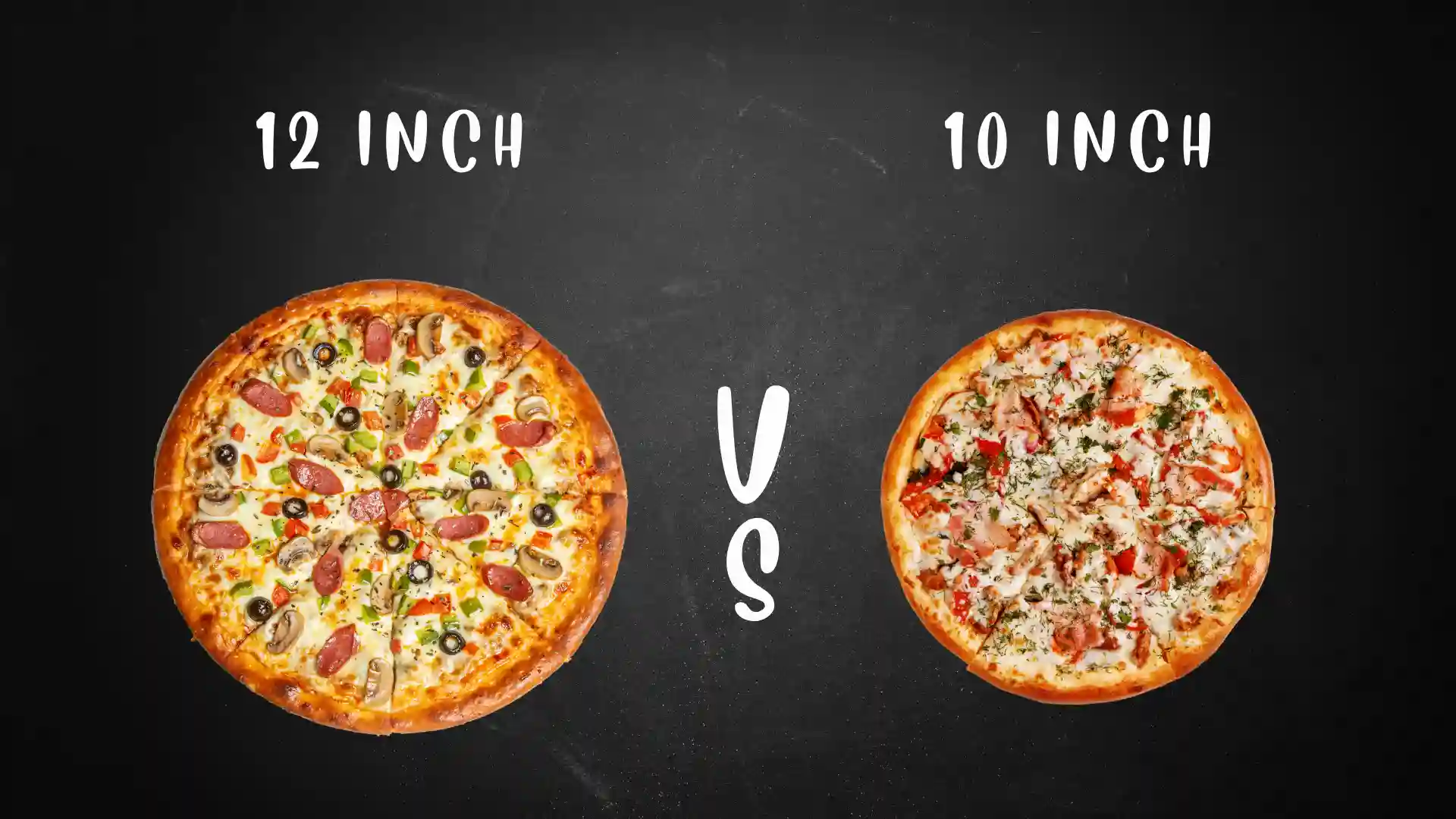A 12-inch pizza is approximately 44% larger than a 10-inch pizza, in terms of area while 2 inches larger in diameter. A 10-inch pizza is great for the personal feast with a thicker crust, while a 12-inch pizza is perfect for sharing at gatherings. Decide between 10-inch vs 12-inch pizza on your desired pizza adventure.
Table of Contents
- What is a 12-inch pizza?
- what is a 10-inch pizza?
- 10-inch vs 12-inch pizza
- How big is a 12-inch pizza?
- How big is a 10-inch pizza?
- what size is a 12-inch pizza | What is a 10-inch pizza size?
- How many slices are in a 12-inch pizza
- A 10-inch pizza has how many slices
- 12-inch pizza calories
- 10-inch pizza calories
- how much cheese for a 12-inch pizza
- how much cheese for a 10-inch pizza
- 12-inch pizza dough weight
- 10-inch pizza dough weight
- Comparing 10-inch vs 12-inch pizza
- Toppings and Portion Control:
- Cooking Time and Temperature:
- Nutrition and Calories:
- Cost and Value:
- Price Comparison
- Expert Opinions
- Conclusion
- FAQs
Pizza is the beloved dish of many all around the world. However, when it comes to choosing the perfect pizza size, a common issue arises – should you go for a 10-inch pizza or opt for a larger 12-inch one?

Pizza, the ultimate comfort food, comes in various shapes and sizes. Among them, 10-inch vs 12-inch pizzas are the most popular sizes, each with its own set of advantages and disadvantages.
For factors such as taste, portion size, cooking time, versatility, and crust-to-topping ratio, we aim to assist you in making an informed decision the next time your pizza craving strikes. So, let’s settle in and discover the differences between these two popular pizza sizes – a battle of 10-inch vs 12-inch pizza.
What is a 12-inch pizza?
A 12-inch pizza refers to a circular pizza with a 12-inch diameter for its width, providing a generous space for different toppings. It is typically considered as a medium-sized pizza, creating a balance between personal-sized options and larger pizzas for sharing.
what is a 10-inch pizza?
A 10-inch pizza is a circular pizza with 10 inches of diameter. This pizza size is considered as a personal or small size, despite its small size it allows a variety of toppings for a flavourful experience.
10-inch vs 12-inch pizza
To calculate the area of a 12-inch pizza, we need to use the formula for the area of a circle, which is:
Area = πr^2
How big is a 12-inch pizza?
A 12-inch pizza is 12 inches in diameter, we can find the radius by dividing the diameter by 2:
Area of a 12-inch pizza
- Diameter = 12 inches
- Radius = 12 / 2 = 6 inches
- Area = π(6)^2 = 3.14 * 36 = 113.04 square inches
12 inch pizza in cm
As a 12-inch pizza is 12 inches in diameter, using the conversion factor :
1 inch = 2.54 cm
Therefore, we can convert 12 inches to centimeters as follows:
12 inches x 2.54 cm/in = 30 cm
A 12-inch pizza is equal to 30 centimeters (cm) in diameter.
How big is a 10-inch pizza?
A 10-inch pizza is 10 inches in diameter, we can find the radius by dividing the diameter by 2:
Area of a 10-inch pizza
- Diameter = 10 inches
- Radius = 10 / 2 = 5 inches
- Area = π(5)^2 = 3.14 * 25 = 78.5 square inches
10-inch pizza size in cm
As a 10-inch pizza is 10 inches in diameter, using the conversion factor :
1 inch = 2.54 cm
Therefore, we can convert 10 inches to centimeters as follows:
10 inches x 2.54 cm/in = 25.4 cm (diameter)
A 10-inch pizza is equal to 25.4 centimeters (cm) in diameter.
what size is a 12-inch pizza | What is a 10-inch pizza size?
The primary difference between 10- and 12-inch pizzas lies in their diameter. A 10-inch pizza measures 10 inches across, while a 12-inch pizza measures 12 inches across. This translates to a 20% increase in surface area for the larger pizza.
Ideal for small gatherings or family meals, the 12-inch pizza shines as a shareable centerpiece, fostering a communal and festive atmosphere.

Perfect for individual indulgence or a cozy night, the 10-inch pizza caters to those seeking a more personal dining experience.
How many slices are in a 12-inch pizza
The number of slices in a 12-inch pizza is typically around 8 slices. However, this can vary based on the specific pizza place and how the pizza is sliced—some may cut it into more or fewer slices. With a larger circumference, the 12-inch pizza tends to have a thinner crust, offering a delightful balance of crispiness and doughy goodness.
A 10-inch pizza has how many slices
A typical 10-inch pizza slice has 6 slices on average. But it can be varied according to one’s personal preferences and choices. Known for a more compact crust, the 10-inch pizza often boasts a thicker edge and a denser bite, providing a satisfying chewiness.
12-inch pizza calories
Generally, the smaller size tends to be a more calorie-conscious option, making it suitable for those mindful of their intake. The number of calories in a 12-inch pizza varies widely depending on the type of crust, toppings, and portion size. On average, a plain cheese 12-inch pizza can contain anywhere from 1,000 to 1,500 calories.
However, this can increase significantly with additional toppings such as meats, cheeses, and extra sauce. It’s essential to consider portion sizes and ingredients when estimating the calorie content of a pizza.
10-inch pizza calories
While offering a heartier meal, the 12-inch pizza may be preferred by those who prioritize a satisfying, indulgent dining experience. The number of calories in a 10-inch pizza depends on the type of crust, toppings, and serving size.
On average, a plain cheese 10-inch pizza can contain around 800 to 1,000 calories. However, this number can vary significantly based on the specific ingredients used. Adding meat, extra cheese, or other high-calorie toppings will increase the calorie count. It’s important to consider portion size and ingredients when estimating the calorie content of a pizza
how much cheese for a 12-inch pizza
For a 12-inch pizza, you would typically use about 8 to 12 ounces of cheese, depending on how cheesy you like your pizza. This amount can vary based on personal preference and the specific recipe you’re following. Adjust the quantity of cheese according to your taste preferences and desired level of cheesiness.
how much cheese for a 10-inch pizza
For a 10-inch pizza, you would typically use about 6 to 8 ounces of cheese. Again, this amount can vary based on personal preference and the specific recipe you’re using. Adjust the quantity of cheese according to your taste preferences and desired level of cheesiness

12-inch pizza dough weight
To prepare a 12-inch pizza, you’d typically require around 9 ounces of pizza dough, which is approximately 250 grams. This estimation accounts for variations in crust thickness and personal preference. Adjust the dough quantity as needed to achieve the desired crust texture and thickness for your homemade pizza
The specific amount can be influenced by factors such as the desired thickness of the crust and the particular recipe you are following. For a thinner crust, you might opt for the lower end of the dough range, while a thicker crust may require a bit more
10-inch pizza dough weight
To prepare a 10-inch pizza, you would generally require around 7 ounces of pizza dough. That is almost 200 grams. This amount can vary based on your desired crust thickness and the specific recipe you’re following. Adjust the dough quantity accordingly for a perfect homemade pizza.
This estimate can vary based on factors such as crust thickness and recipe specifics. Adjusting the amount of dough can help achieve the desired crust thickness and overall texture of the pizza. It’s advisable to refer to your chosen pizza dough recipe for precise measurements and instructions tailored to your preferences.
Comparing 10-inch vs 12-inch pizza
Choosing between a 10-inch and 12-inch pizza ultimately boils down to personal preference, lifestyle, and budget. Both sizes offer unique benefits, from the thicker crust and portion control of a 10-inch pizza to the thinner crust and expanded topping possibilities of a 12-inch pizza. Consider your appetite, the number of people you’re feeding, and your craving for a particular style of pizza when deciding which size to order.
Toppings and Portion Control:
When it comes to toppings, both sizes offer enough space for a generous amount of ingredients. However, the 12-inch pizza provides a greater canvas for creativity, enabling you to add more toppings and experiment with different combinations. On the other hand, the 10-inch pizza might require a bit more strategic planning regarding topping placement, ensuring that every bite contains a balanced mix of flavors and textures.
Cooking Time and Temperature:
The cooking time and temperature for 10-inch and 12-inch pizzas differ slightly. Because of its smaller size, a 10-inch pizza cooks faster and at a lower temperature than a 12-inch pizza. This means the cheese on a 10-inch pizza might be slightly more browned and bubbled, while the crust could be crisper. Conversely, a 12-inch pizza requires a longer cooking time and higher temperature to achieve optimal doneness, resulting in a potentially softer crust and milder cheese flavor.

Nutrition and Calories:
A 10-inch pizza generally contains fewer calories than a 12-inch pizza due to its smaller size. According to data, a standard 10-inch pizza contains approximately 1,200-1,400 calories, while a 12-inch pizza packs around 1,600-1,800 calories. However, it’s essential to note that topping choices significantly impact nutritional values, so choosing healthier toppings like vegetables, lean proteins, and low-fat cheeses can help minimize caloric intake regardless of pizza size.
Cost and Value:
The cost of a 10-inch versus a 12-inch pizza largely depends on the establishment and location. However, in general, 10-inch pizzas tend to be less expensive than their larger counterparts. This price difference stems from the fact that 10-inch pizzas require less dough, toppings, and cooking time, resulting in lower production costs. That said, some argue that the increased surface area of a 12-inch pizza provides better value since you get more toppings and a larger shareable pie.
Price Comparison
When it comes to the size of your pizza, one of the factors that often comes into consideration is the price. So, is bigger always better, or does quality triumph over quantity?
Cost per Square Inch Analysis
Let’s break it down. If we do a cost-per-square-inch analysis, we can determine which size gives you more bang for your buck. Generally, larger pizzas are more cost-effective since you get more pizza for the same price. However, it’s important to note that this analysis doesn’t take into account the quality of the ingredients or the overall taste.
Considering Quality Ingredients
Speaking of quality, sometimes it’s worth paying a bit extra for better ingredients. Smaller pizzas often allow for more attention to detail, ensuring that each bite is packed with flavor. While you may get less pizza overall, the quality and taste can make up for it. It’s all about finding the right balance between size and quality that suits your preferences and budget.
Expert Opinions
To further explore the topic, we reached out to some experts in the field – chefs, pizzaiolos, and pizza enthusiasts – to get their insights and recommendations on pizza sizes.

Chef Recommendations and Insights
According to many chefs, the size of the pizza should depend on the occasion and the number of people you’re serving. Some argue that smaller pizzas allow for better attention to detail and flavors, while others emphasize the social aspect of sharing a larger pie.
Perspectives from Pizza Lovers and Enthusiasts
When it comes to pizza lovers and enthusiasts, opinions vary. Some prefer larger pizzas for their value and variety, while others opt for smaller pizzas to fully appreciate the quality and craftsmanship of the dough and toppings. Personal preference plays a significant role in determining the ideal pizza size.
Conclusion
In the end, the choice between a 10-inch or 12-inch pizza comes down to your personal preferences, budget, and the occasion. Larger pizzas may offer more slices and variety, making them suitable for social gatherings. On the other hand, smaller pizzas can provide a more intimate dining experience and allow for attention to detail and quality ingredients.
In conclusion, the choice between a 10-inch and 12-inch pizza ultimately depends on your personal preferences and specific circumstances. While a 10-inch pizza offers concentrated flavors, perfect for individual servings and quick cooking, a 12-inch pizza provides versatility in toppings, shareability, and a balanced crust-to-topping ratio. It’s important to consider factors such as occasion, budget, and the number of people you’re serving. By understanding the pros and cons of each size and taking into account expert opinions, you can confidently make a decision that suits your pizza cravings. So, whether you opt for the smaller or larger size, what truly matters is indulging in delicious pizza that brings joy and satisfaction to your taste buds.
When it comes to the world of pizza, size matters. The 10-inch and 12-inch pizzas are popular choices, each offering a unique dining experience. In this detailed exploration, we dive into the nuances of these two sizes, comparing their crusts, toppings, serving sizes, and overall appeal.
So, the next time you’re faced with the eternal question of pizza size, consider your cravings, consider your company, and choose accordingly. Remember, whether it’s 10 inches or 12 inches, a good pizza is always a delicious adventure!
FAQs
[sp_easyaccordion id=”3439″]
